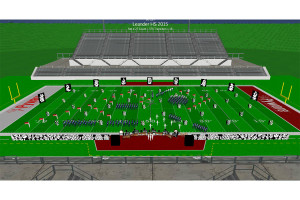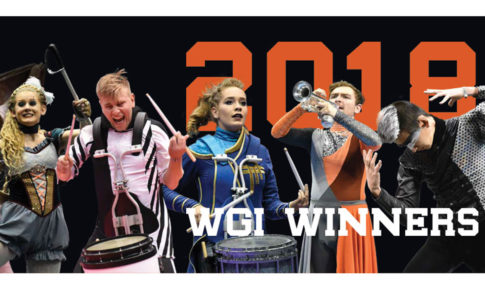From abstract forms to pictorial animation, how have drill formations evolved over the years, and what are the latest trends?
Marching has come a long way from military drills and squad commands. Today’s field shows hardly resemble parade blocks or company fronts. Instead, abstract creative forms, words and numbers, pictorial icons, moving pictures and intricate textures fill the field to create visual moments and emotional responses when combined with music.
A Moment Like This
Out of the old military style emerged “show band” style, with pictures and simple forms, followed later by the emergence of what we now call “corps style,” less literal, continuous formations that accompany the feel of the music being played. Now, the pictorial forms are re-emerging as moments within a corps-style show.
“It’s more of a fusion than it is the same style throughout the whole show, and that’s where the pendulum may swing back,” says Lee Carlson, a Drum Corps International (DCI) and Bands of America (BOA) visual judge. “It may go further into the pictorial quality stuff, or it may come back to doing more corps style.”
Drill and visual design is becoming more theatrical and complex, with more emphasis placed on big show-stopping moments.
“I think there’s less emphasis on drill and more emphasis on creating an entertaining package,” says drill designer Noah Bellamy. “The drill to me has almost taken a backseat to creating an entertaining, memorable show that gets inside of you, and you can’t forget.”
As designer for Plymouth-Canton (Michigan) Marching Band, a number of WGI drumline groups and the Troopers Drum and Bugle Corps, Bellamy has noticed the increasing importance of creating big moments, starting from the earliest stages of show design.
“We decided … to create memorable moments, and then we picked music that would best fit the moments that we wanted to create, which I think is really a different approach than even 10 to 15 years ago, where sometimes the music was picked, and then we wrote drill to the music,” Bellamy says.
One of his biggest inspirations was Michael Gaines in the early 2000s, but Bellamy cites the rule changes of the 1980s as the biggest shift in drill design, allowing designers like George Zingali, Steve Brubaker and Marc Sylvester to really let loose and get more creative.
“The judging system before was all based on ticks, and it was judges going out and deducting points for individual errors,” he says. “But they got rid of the tick system and started to award accomplishments for groups rather than always looking for things that were wrong. That’s when we started to see a lot of groups take more risks.”
 Abstract Action
Abstract Action
For years, bands have ventured more and more into the abstract, a trend that is only continuing among some groups or as part of shows.
“More asymmetrical, more abstract, a lot more artistic,” says Mike Stone, a DCI and BOA visual judge. “I think people are getting really talented as far as what they’re able to offer in long phrases of drill. Some of the things that they’re asking the performers to do are pretty incredible [as far as] the complexities of what they’re asked to do visually.”
Drill designer Jeremy Hunt, who writes for Leander and Round Rock High Schools in Texas, among others, likes to employ what he calls unstructured or textured drill formations.
“Where it’s mood and feel, it’s not necessarily concrete forms, but there’s a lot more on the individual performers to do things that create textures and not to necessarily achieve a shape,” he says. “Everything is possible, and everything is rewardable, so do crazy non-structured things. I want to see how far I can push it.”
Can You Picture That?
As university bands go viral on a weekly basis with their theme shows and pictorial drill formations, the practice has started to make a comeback in both high school marching band and drum corps.
“I always think it’s fun to see what [the college bands] are doing,” Bellamy says. “And I don’t know if that’s influencing what’s happening in our activity, but it’s generating buzz about the activity, which is always a great thing.”
With a college halftime show, the goal is pure entertainment, and while staying competitive, corps and high schools are embracing more elements that a general audience can respond to.
“People are going to a football game to be entertained and have a good time,” Hunt says. “That’s why you never see a college band do a heavy, heavy show because it’s the wrong environment. It’s a Michael Jackson show, so it has a moonwalk. Why not? That’s exactly what you should do.”
Although some express fear that pictorial drill can be too cliché, Hunt, who wrote the drill for Phantom Regiment’s 2015 program, says it’s all in the context.
“I don’t think it’s cheesy at all in the right context,” he says. “Whatever helps propel your show forward is totally fine.”
This last summer alone, several corps did pictorial formations: The Blue Devils spelled out “INK,” the Cadets’ Roman numeral “X,” the Colts with the chalk outline of a body, Phantom Regiment’s Eiffel Tower and the Troopers horse head formation, to name a few.
“The way that we artistically got into that set, where it came in the show, what music we were playing while we saw that picture, those are all things that I think can take some of that clichéness out of it,” Bellamy says. “So I think the design process can dictate whether or not it’s seen as being cheesy or not cheesy.”
Applause, Applause
One of the benefits of pictorial drill formations is the increased likelihood of audience reaction. “A recognizable form can get the attention of the entire audience, not just your band’s parents,” says Carlson, who also writes drill for colleges and high schools when he’s not judging. “The crowd really responds to it when they can figure out what the band or corps is doing. They feel like they’re more a part of the show. So the crowd reaction to the pictures has been really good both in drum corps and marching band.”
Chances are that if total strangers or people unfamiliar with the marching arts like your show, then the judges are probably going to like it too.
“One thing I say to a lot of band directors is if we can get the football audience to clap, there’s some things that we are doing right that will naturally transfer over to the competitive audience,” Hunt says.
However, Stone warns against over-pandering to the crowd when you’re in a competitive circuit.
“I think audiences respond to things that they can understand and gravitate to very easily,” he says. “And that’s not always necessarily what the judging sheets are being asked to respond to, so it does create a little bit of a conflict sometimes between the judges and the audience. But certainly when the audience responds to something, typically we would respond to that as well.”
And although drum corps are locked in intense competition, they need to entertain as well.
“Every night almost, we have a contest in a stadium that’s full of people that pay a lot of money for a ticket to come and be entertained, and we need to make sure that we don’t forget that,” Bellamy says. “So we try to come up with things that people can relate to and people can understand. That can’t be lost in the design process.”
Jaw Dropping
The overarching trend across all activities in the marching arts is increased excellence, precision and artistry that drop jaws and open eyes around the world.
“The trend is that we’re getting these kids in these top corps that can really do anything that they’re asked to do,” Bellamy says. “It’s amazing and freeing because as a designer, you can literally do just about anything that you want. So that’s the trend that I think is awesome: just the unabashed creativity. It’s a very exciting time, I think, to be a part of this activity.”
When a great show comes together visually and musically, the reward is an emotional experience for the audience. “I think those shows that can offer the intellectual and emotional and combine those things together, that tends to be maybe when you get recognized the most,” Stone says. “When you’re able to do things that are a combination of all of those elements.”
As the creativity increases, certain corps and bands are developing signature styles of their own.
“There’s becoming more identity within the programs, and they’re separating themselves in what they do,” Carlson says. “People are exploring more ways to do space and time and weight, and that’s really good because it’s becoming more creative, and it’s making the judges work harder. It’s a challenge for the judges because we’re not comparing apples to oranges anymore. We’re doing apples to avocados to teriyaki.”
Technology’s Role
Technological advances have played a huge part in the increased creativity in drill design in recent years. Drill software has advanced to video game-like visualizations.
“[Drill software] used to be just dots moving around, but now you can see the flags spinning with the 3D renderings,” Hunt says. “It essentially saves time, which in the end helps the kids save time.”
Many directors and instructors show their students videos of the drill before teaching it. “It makes the drill cleaner,” Carlson says. “The more they can see how the individuals fit into the ensemble, the entire picture, the better they’re going to be able to understand what their responsibilities are.”
Affordable digital printing has also helped bands and indoor groups enhance their themes. “Printing being affordable now has helped a ton,” Hunt says. “What’s more obvious than if you do a show about Renoir, and you have a tarp with his painting? You’d never be able to create a drill chart that looks like that.”
And of course, YouTube and online video means that anyone in the world can see your field show, driving bands to emphasize originality or draw inspiration from others.
“I think 20 years ago, Ohio State could have done these shows, and it wouldn’t have mattered,” Carlson says. “But with YouTube and everything else now, it was all over Facebook and everything, and it was great.”
While technology has helped fuel innovations, the drill designers themselves are the true drivers of creativity.
“Technology helps, but I just think the people that are out there designing are incredibly talented, and they’ve evolved over the years and just have become extraordinary at what they do,” Stone says. “I know some really great designers that don’t even use the technology that’s available to them, and they’re still able to create fantastic visual programs.”


